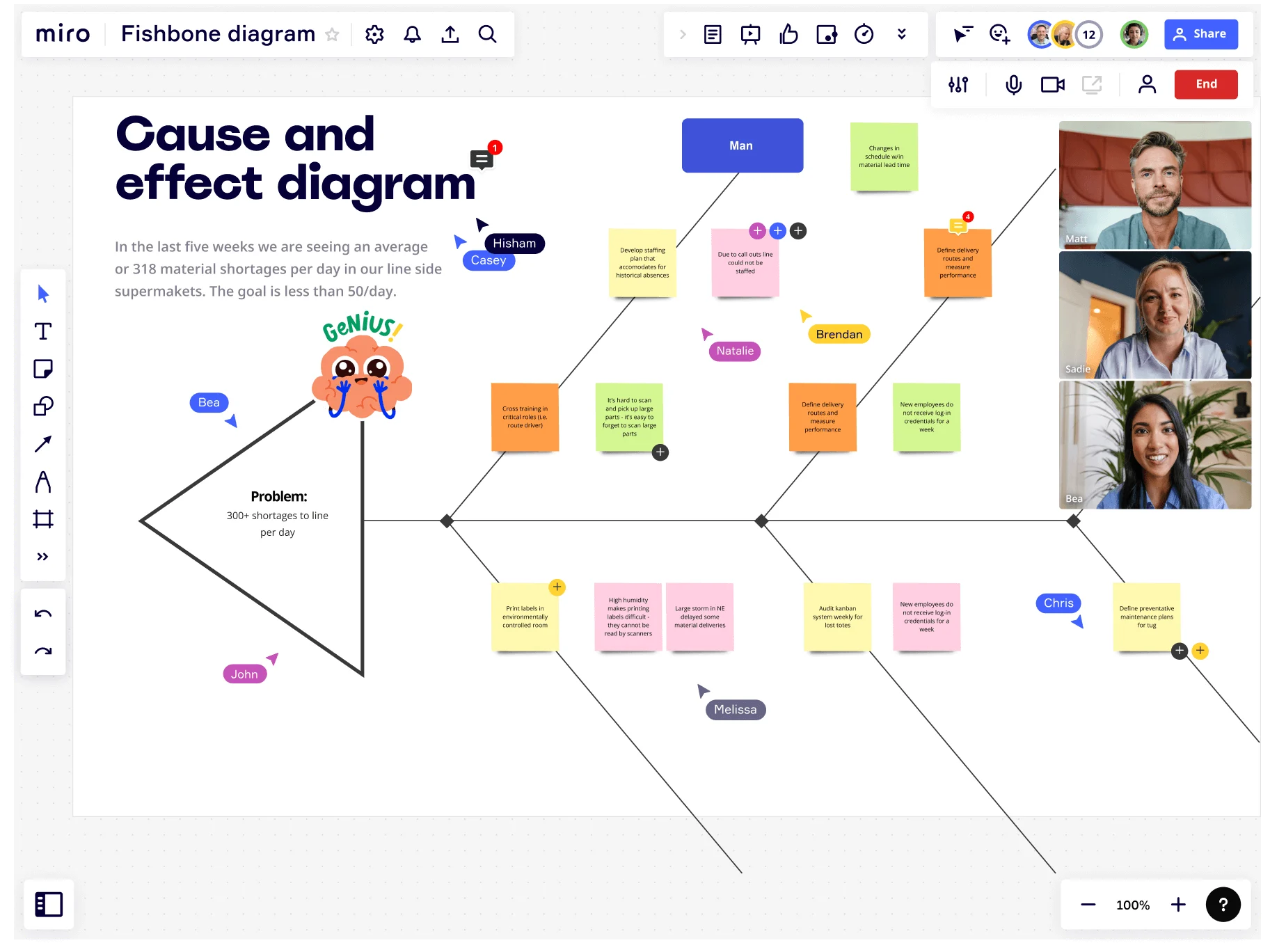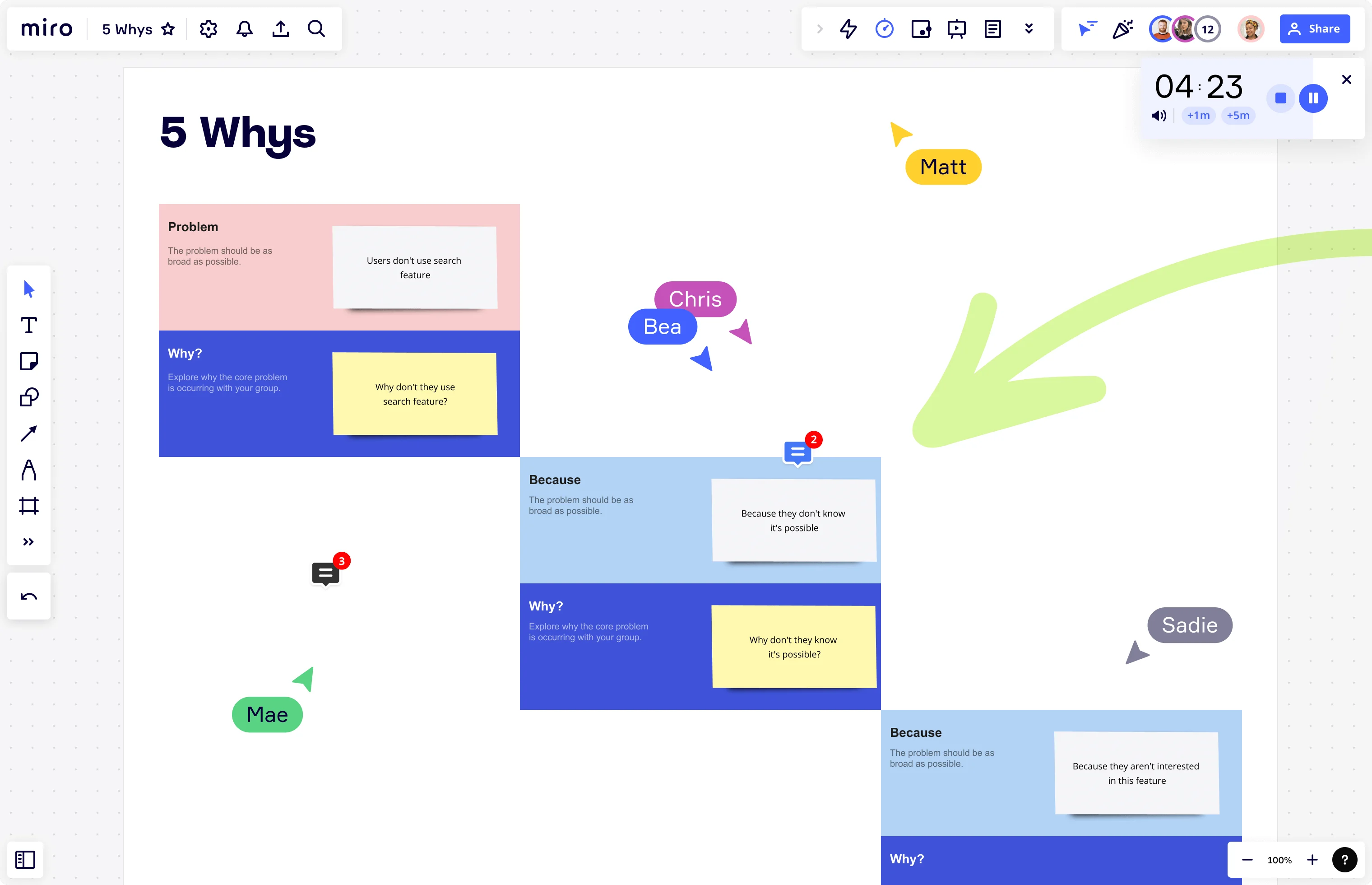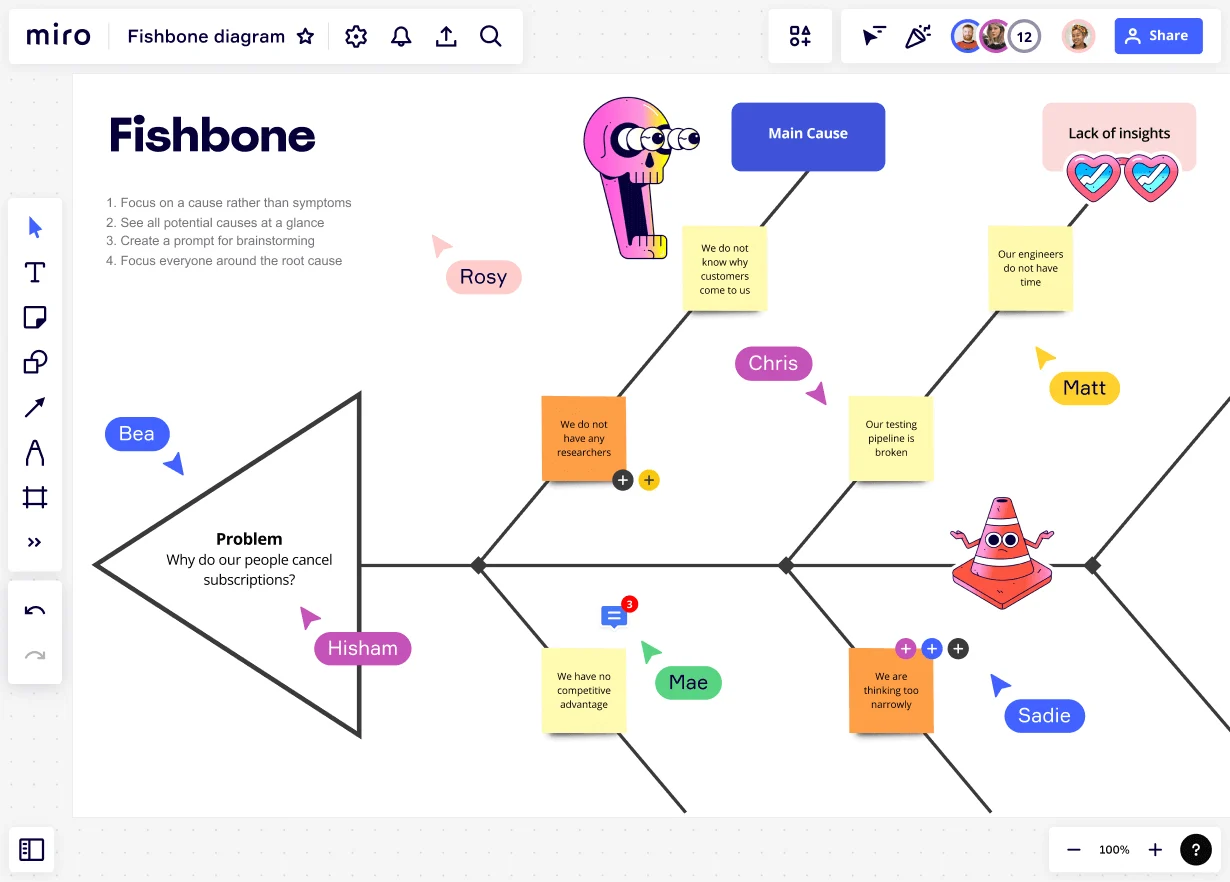
Table of contents
Table of contents
What is root cause analysis?

Summary
In this guide, you will learn:
What root cause analysis (RCA) is and why it is important for solving problems effectively
The 6-step process of conducting root cause analysis, from defining the problem to implementing solutions
How to gather information and identify potential causes using collaborative tools
Key RCA techniques such as the 5 Whys and Fishbone Diagram and how to apply them
How to use Miro’s templates and tools to visualize and organize root cause analysis
Ways to engage teams in real-time or asynchronous collaboration to uncover insights and drive improvements
Try Miro now
Join thousands of teams using Miro to do their best work yet.
Drive effective solutions with a root cause analysis
Have you ever found yourself dealing with a problem that just won't go away, no matter how many times you try to fix it? Maybe you've spent countless hours troubleshooting, only to have the issue resurface time and time again.
Conducting a root cause analysis can lead you to the right solution. This powerful tool allows you to dig deep and uncover the underlying issues that are causing recurring problems.
In this article, we'll dive into the ins and outs of root cause analysis, and explore how it can revolutionize the way you work.
What is a root cause analysis?
Root cause analysis is a problem-solving technique that helps organizations and individuals understand why things go wrong. It can help identify potential solutions and prevent similar issues from occurring in the future.
When something goes awry in a system or process, it's often tempting to treat the symptoms and move on. However, without identifying and addressing the root cause of the problem, the same issue will likely keep cropping up.
Root cause analysis is not a particular tool but rather a structured and objective approach to problem-solving. The process involves digging deep into the underlying factors contributing to the problem. By identifying the root cause, organizations can develop practical solutions that address the source of the issue rather than just treating the symptoms.
6 steps of root cause analysis
The following is a step-by-step guide for how to do root cause analysis:
1. Define the problem
Before identifying the cause of a problem, you first need to understand the issue entirely.
Start by clearly defining the problem so that you fully understand the situation. This process involves gathering data, examining processes, and determining the impact of the problem on your organization.
Here are some questions you can ask to help you define the problem you want to solve:
What is the problem? Can you describe it in detail?
When did the problem start, and how often does it occur?
Who is affected by the problem?
What is the impact of the problem on the organization, customers, or stakeholders?
What are the current processes or systems that are affected by the problem?
What resources are available to address the problem, including personnel, budget, and technology?
By asking these questions, you can better understand the problem and develop a clear problem statement. These questions and their answers will help set the scope and direction of your root cause analysis.
2. Gather information
Next, collect relevant data and information about the problem. Approach anyone involved or affected by the problem and ask for their input. Conduct interviews with stakeholders, survey employees, and review historical data and records. Observing the processes or systems affected by the problem can provide first-hand insights into the issue.
3. Identify potential causes
Use the data collected to identify possible contributing factors to the problem. Hold a brainstorming session with people that have knowledge or experience related to the problem. Encourage everyone to generate as many possible causes as possible without judging them.
Next, organize the potential causes into categories, such as physical causes, human causes, and organizational causes. Categorizing the potential causes can help to identify common themes and patterns.
4. Analyze causes
Once you’ve gathered enough potential causes, carefully analyze each one. At this point, your team should have generated a significant number of possible reasons for the problem, and not all of them will be relevant.
Take a deeper dive into each cause, deciding on the likelihood that this is what’s causing the problem. Decide whether it’s just one cause or several interconnected causes.
After careful analysis and discussion with your team, you should end this step with a good idea of what’s causing the problem.
5. Develop and implement solutions
You’ve identified the problem and what’s causing it. Now it’s time to turn your attention to solutions.
Based on your analysis, develop corrective actions that address the underlying problem.
6. Monitor results
Implement the corrective actions and monitor the results to ensure they work as intended. You may find that there are additional issues that need to be addressed.
This step can involve reviewing performance metrics, gathering feedback, and conducting follow-up assessments to ensure the problem has been fully resolved. If the issue still needs to be addressed, revisit your solution or consider other potential causes.
Benefits of root cause analysis
Root cause analysis has several benefits that make it a valuable tool for problem-solving and decision-making. Some of the benefits of root cause analysis include:
Prevention of future problems
Root cause analysis helps to identify the underlying cause or causes of a problem rather than just addressing its symptoms. By addressing the root cause, organizations can prevent the problem from recurring. This allows for a more effective and permanent solution.
Improved problem-solving
By using a structured approach to identifying the root cause, the problem-solving process becomes more systematic and efficient. This helps to ensure that all factors contributing to the problem are considered and that the most likely cause is identified.
Improved decision-making
Root cause analysis provides a framework for making informed decisions about addressing the issue. Decisions are made collectively based on data and evidence rather than assumptions or guesswork. This helps to ensure that resources are allocated effectively and that the chosen solution is the most appropriate.
Increased collaboration
Root cause analysis involves gathering input and feedback from multiple stakeholders and employees. This can increase collaboration and communication within an organization.
Continuous improvement
Organizations can continually improve their processes and systems by identifying and addressing the root cause of problems. And by making ongoing changes to processes and systems, teams can ensure they operate at maximum efficiency.
4 root cause analysis techniques
While root cause analysis is a method or approach, there are tools and techniques that provide a framework for this process. Root cause analysis techniques provide a standardized approach to conducting root cause analysis to ensure you consider relevant factors.
Here are our top picks from Miro’s extensive template library to help you implement each of these four techniques.
5 Whys
This technique is a simple yet effective root cause analysis technique. It involves asking five consecutive "why" questions, each time using the answer to the previous question as the basis for the next question.

By looking at the problem from this inquisitive approach, you can drill down to the root cause of the problem. Use the 5 Whys Templates to provide support for the technique.
Fishbone Diagram
The Fishbone Diagram is also known as the Ishikawa Diagram or cause-and-effect diagram. This visual tool gets its name because of its shape, which resembles the skeleton of a fish.

To use this technique, define the problem statement at the head of the fishbone and draw the major branches for each category of potential causes. Then mindmap the possible causes for each category (major branch) and add them as sub-branches. Finally, analyze each potential cause and identify the root cause of the problem.
FMEA Analysis
FMEA Analysis stands for Failure Mode and Effects Analysis. It is a proactive approach to identifying and mitigating potential failures in a system or process and then developing preventive and corrective actions.
It is different from most root cause analysis techniques because it is intended to find potential issues and stop them before they happen.
Follow these steps when performing FMEA:
Identify the system or process to be analyzed and list the potential failure modes.
Analyze the possible effects of each failure mode on the system or process.
Rate them based on their severity, occurrence probability, and detectability.
Prioritize the failure modes and develop preventive and corrective actions.
Use the FMEA Analysis Templates to help guide you in using this technique.
DMAIC Analysis
DMAIC stands for Define, Measure, Analyze, Improve, and Control. This versatile tool was originally developed as part of the Six Sigma initiatives to enhance the manufacturing process. However, this problem-solving methodology is useful for other processes by identifying and eliminating the root causes of defects.
The DMAIC approach is made up of five phases:
Define the problem statement and project goals.
Measure the current performance of the process.
Analyze the data to identify the root causes of defects.
Improve the process by implementing solutions.
Control the process to sustain the improvements.
Use the DMAIC Analysis Template as a framework to organize and document each stage of this problem-solving approach.
Root cause analysis example
Let’s look at a practical example of a team conducting a root cause analysis.
Imagine a dev team experiencing difficulty with the product-login process. To understand the root of this issue, the team uses the 5 Whys framework.
Why are users having difficulty logging in?
There’s an issue with the new code we pushed.
Why is there an issue with the new code we pushed?
We wrote the code in a hurry.
Why did we write the code in a hurry?
We didn’t have much time to release the new feature.
Why didn’t we have enough time to release the new feature?
We kept changing what we wanted to build.
Why did we keep changing what we wanted to build?
We didn’t have a deep understanding of our customer’s problems.
In this example, the 5 Whys framework helped the dev team identify the root cause of the problem and develop a plan to address it. It provided a structured and systematic approach to problem-solving, helping the team identify the underlying factors contributing to the problem.
Ultimately, the root cause of the problem is that the dev team didn’t fully understand the customer's needs and requirements. By identifying the root cause, the team can develop solutions to prevent similar issues in the future. In this case, they may need to invest more time in user research and requirements gathering.
Root cause analysis best practices
Here are some best practices to follow during your root cause analysis to ensure the process is effective.
Involve the right people
This includes people with expertise in the area of the problem and anyone directly impacted by it. Bringing together a diverse group of individuals can provide a well-rounded perspective and increase the likelihood of identifying the root cause accurately.
Use the right tools
Using the right tools can make the root cause analysis process easier and more effective. Miro provides a range of features that can support the process, such as real-time collaboration, data visualizations, and customizable templates.
By providing structured root cause analysis templates, Miro helps teams stay organized and focused during the root cause analysis process. Our platform also allows teams to organize and structure data effectively, ensuring that the analysis is comprehensive and systematic.
Gather sufficient data
Collecting relevant data can help identify patterns, trends, and relationships between different factors contributing to the problem. This includes both quantitative and qualitative data.
Consider all causes
Make a conscious effort to look beyond the most obvious causes and explore other potential factors that may have contributed to the issue. Considering all possible causes makes the analysis more comprehensive, making the resulting solutions more effective in addressing the root cause.
Solve problems like a pro with root cause analysis
Root cause analysis provides a structured approach to problem-solving, allowing you to identify the underlying cause of an issue and develop a solution that addresses it directly. This not only saves time and resources but also leads to more sustainable results.
By using root cause analysis, you can avoid getting stuck in a never-ending cycle of putting out fires and instead take a proactive approach to problem-solving. This means that you can solve problems before they even arise, ensuring that your business or personal life runs smoothly and efficiently.
Miro provides a variety of templates and root cause analysis tools to help you and your team conduct a structured analysis.
Author: Miro Team
Last update: October 22, 2025